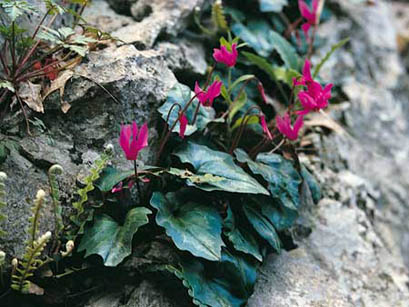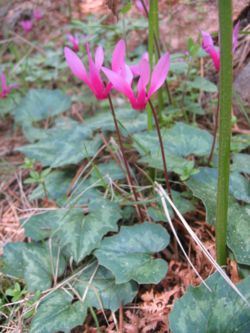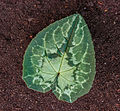Nome comune: ciclamino a foglie d’edera, ciclamino autunnale
Specie: Cyclamen hederifolium Aiton
Famiglia: PRIMULACEAE
Nei nostri boschi, questo ciclamino fiorisce tra la fine dell’estate e l’inizio dell’autunno, a partire dalla fine del mese di agosto. Ha un’altezza compresa tra i 10 e i 30 cm.
- I fiori, di colore rosa chiaro, quasi sbiadito, non profumati, hanno la fauce della corolla che forma un pentagono ad angoli dentati. I lunghi e sottili steli che li sorreggono emergono dal terreno privi delle foglie, che compariranno solo dopo la fioritura.
- Le foglie sono bislunghe, spesso macchiate; come detto, compaiono solo la fioritura
Nome comune: ciclamino di primavera
Specie: Cyclamen repandum Sm.
Famiglia: PRIMULACEAE
Fiorisce nei boschi con l’arrivo della primavera. Può raggiungere l’altezza di 20 cm.
- I fiori sono solitari, reclinati, molto profumati, con corolla di colore rosa intenso, scuro (rosa ciclamino).
- Le foglie, che si sviluppano prima del fiore, sono ovate picciolate, variegate di chiaro sulla pagina superiore.
Nei ciclamini, il fusto sotterraneo (ipogeo) è praticamente il tubero, più o meno sferico e schiacciato, da cui si diramano delle sottili radici secondarie; la parte aerea, epigea, è lo scapo fiorale, semplice e senza foglie.
Tossicità
I principi attivi sono i saponosidi, tra cui ricordiamo la ciclamina; sono presenti, specialmente, nei tuberi.
Il ciclamino è velenoso per ingestione e, se maneggiato a lungo, può causare infiammazioni e dermatiti.
Curiosità
l nome del genere, Cyclamen, deriva dalla parola greca kyklos (= cerchio), forse in riferimento alle radici tuberose, di forma rotondeggiante.
Nelle zone “arate” dai cinghiali è facile trovare tuberi di ciclamino che i voracissimi suidi selvatici neppure assaggiano.
Il ciclamino, tuttavia, è conosciuto popolarmente anche con il nome di pan porcino, ad indicare che, invece, i maiali se ne cibano volentieri.
Galleria
 Link da Actaplantarum: Cyclamen repandum
Link da Actaplantarum: Cyclamen repandum
Indice
Cyclamen repandum
Il ciclamino primaverile (Cyclamen repandum Sm.) è una specie di pianta erbacea perenne appartenente alla famiglia delle Primulacee[1].
Descrizione
Portamento
Pianta erbacea semi-rustica geofita bulbosa alta tra i 10 ed i 20 centimetri.
Foglie
Le foglie hanno forma triangolare, delle dimensioni comprese tra i 4-8 centimetri in larghezza ed 4-9 centimetri in lunghezza e con un lungo picciolo variabile tra i 6 ed i 16 centimetri. Il margine si presenta lievemente lobato. La pagina superiore è di colore verde scuro con variegatura argentea mentre quella inferiore si presenta di colore variabile dal rosso al verde chiaro.
Fiori
Il fiore è unico, di colore viola chiaro o fucsia, inodore e con un peduncolo di 12-20 centimetri. Il tubo corollino ha un diametro di 6-7 millimetri. Le lacinie sono rivolte all'indietro e delle dimensioni di 5-6 millimetri di larghezza e 18-22 millimetri di lunghezza. La fioritura avviene in primavera, nel periodo compreso tra aprile e maggio.
Radici
La radice è costituita da un tubero tondeggiante del diametro di 2-6 centimetri. Le radichette si formano nella zona centrale della faccia inferiore mentre, sulla faccia superiore, si sviluppano le foglie ed i fiori.
Distribuzione e habitat
È originaria dell'Europa meridionale e dell'Italia. Il suo habitat naturale è rappresentato dai boschi ombrosi di leccio e dalla macchia di cespugli anche se, raramente, si può trovare nei boschi decidui. Vegeta a quote comprese tra 0 e 1.200 metri.
Usi
Usi terapeutici
Recenti studi hanno dimostrato le proprietà analgesiche ed antinfiammatorie della pianta[2].
Note
- ^ (EN) Cyclamen repandum, su Plants of the World Online, Royal Botanic Gardens, Kew. URL consultato il 13 ottobre 2023.
- ^ E. Speroni, R. Cervellati; S. Costa; S. Dall'Acqua; M. C. Guerra; C. Panizzolo; A. Utan; G. Innocenti, Analgesic and antiinflammatory activity of Cyclamen repandum S. et S. [collegamento interrotto], in Phytotherapy Research, vol. 21, n. 7, 2007, pp. 684-689, DOI:10.1002/ptr.2145. URL consultato il 20 dicembre 2009.
Bibliografia
- Sandro Pignatti, Flora d'Italia, Bologna, Edagricole, 1982, Volume 2, p. 287, ISBN 88-506-2310-0.
- Renato Brotzu, Fiori spontanei della Sardegna, Nuoro, Edizioni Il Maestrale, 2000, p. 76, ISBN 88-86109-18-0.
Altri progetti
 Wikimedia Commons contiene immagini o altri file su Cyclamen repandum
Wikimedia Commons contiene immagini o altri file su Cyclamen repandum Wikispecies contiene informazioni su Cyclamen repandum
Wikispecies contiene informazioni su Cyclamen repandum
Collegamenti esterni
- (EN) Cyclamen repandum nel database IPNI, su ipni.org.
 Link da Actaplantarum: Cyclamen hederifolium
Link da Actaplantarum: Cyclamen hederifolium
Contents
Cyclamen hederifolium
| Cyclamen hederifolium | |
|---|---|

| |
| Scientific classification | |
| Kingdom: | Plantae |
| Clade: | Tracheophytes |
| Clade: | Angiosperms |
| Clade: | Eudicots |
| Clade: | Asterids |
| Order: | Ericales |
| Family: | Primulaceae |
| Genus: | Cyclamen |
| Species: | C. hederifolium
|
| Binomial name | |
| Cyclamen hederifolium | |
| Synonyms | |
|
Cyclamen neapolitanum Ten. | |
Cyclamen hederifolium, the ivy-leaved cyclamen or sowbread, is a species of flowering plant in the family Primulaceae. This widespread cyclamen species is widely cultivated and among the most hardy and vigorous in oceanic climates. It is native to woodland, shrubland, and rocky areas in the Mediterranean region from southern France to western Turkey and on Mediterranean islands, and naturalized farther north in Europe and in the Pacific Northwest.
Names
The species name hederifolium comes from the Latin hedera (ivy) and folium (leaf),[1] because of the shape and patterning of the leaves. The older species name, neapolitanum, refers to Naples, where the species grows.
Description

Cyclamen hederifolium is a tuberous perennial that blooms and sprouts leaves in autumn, grows through the winter, and goes dormant before summer, when the seed capsules ripen and open.
Tuber

The tuber is round-flattened and produces roots from the top and sides, leaving the base bare. In the florist's cyclamen (Cyclamen persicum), roots come from the bottom, leaving the top and sides bare.
The tuber becomes larger with age; older specimens commonly become more than 25 cm (10 in) across. In other species, tubers do not grow as large; Cyclamen coum usually does not reach more than 6.5 cm (2.6 in) across.
Leaves and flowers grow from buds on the exposed upper surface of the tuber.
Leaves
The leaves are variably shaped and colored. Depending on the specimen, leaf shape varies from heart-shaped to long and arrow-shaped, usually with 2-3 angled lobes on each side, resembling the juvenile leaves of ivy (Hedera). Leaf color varies from all-green to all-silver, but the most common is a Christmas tree or hastate pattern in silver or pewter and various shades of green.
The petiole and flower stalks of Cyclamen hederifolium grow outwards and then up, forming an "elbow". Plants in narrow pots often have a ring of leaves around the outside of the pot. From Latin, 'hederifolium' translates to Ivy-like leaves. In the closely related Cyclamen africanum, stalks grow up from the tuber without a bend near the base.
-
typical leaves
-
an all-silver leaf form
-
leaves collected on Zakynthos, showing range of leaf shapes
-
Leaf Cyclamen hederifolium.
-
New leaf among fallen autumn leaf.
Flowers
The flowers bloom from late summer to autumn and have 5 petals, usually pink, purple, or white with a streaky magenta V-shaped marking on the nose, but sometimes pure white with no markings.
The edges of the petals near the nose of the flower are curved outwards into strong auricles. These are not present in some other species, such as Cyclamen persicum. The flowers are occasionally fragrant. The shape of the flower varies from long and thin to short and squat.[2]
-
flowers with particularly prominent auricles
-
short flowers with wide noses
-
underside of auricles
Fruit
After fertilization, the flower stem coils tightly, starting at the end, and rests above the tuber. Seeds are amber, held in a round pod, which opens by 5-10 flaps at maturity.
-
coiling flower stalk
-
Pods and exposed tubers
Cultivation

Cyclamen hederifolium is usually listed as the hardiest species of cyclamen. In oceanic climates, it self-seeds abundantly and will crowd out less vigorous species such as Cyclamen coum if the two are planted together. In cold continental climates such as Calgary, Alberta, where Cyclamen purpurascens grows well, it may not survive.[3] DavesGarden.com lists it as hardy to zone 5a (−20 °F or −29 °C), although hardiness is dependent on presence of snow cover.
This plant has gained the Royal Horticultural Society's Award of Garden Merit[4] (confirmed 2017).[5]
Subdivisions
Varieties and forms

There are two varieties or subspecies (hederifolium and confusum), and var. hederifolium has two named forms, differentiated by leaf and flower characteristics.
- Cyclamen hederifolium var. hederifolium — leaves with well defined markings
- C. hederifolium var. hederifolium forma hederifolium — pink or purple flowers with darker markings at the base of the petals
- C. hederifolium var. hederifolium forma albiflorum — white flowers, sometimes with pale pink throat — this form has also won the RHS AGM [6]
- Cyclamen hederifolium var. confusum — fleshier leaves with poorly defined markings
The variety Cyclamen hederifolium var. poli, with long sagittate (arrowhead-shaped) leaves, is listed by the Pacific Bulb Society.
-
Cyclamen hederifolium var. hederifolium forma hederifolium (purple flowers)
-
Cyclamen hederifolium var. hederifolium forma albiflorum (all-white flowers)
Cyclamen hederifolium var. confusum (C. confusum)

In chromosome count, var. confusum is tetraploid, while var. hederifolium is diploid.
Recently var. confusum has been elevated to the level of species as Cyclamen confusum,[7] although this is not reflected on GRIN.[8]
Cultivars
There are a number of cultivated varieties of Cyclamen hederifolium.
Cyclamen hederifolium 'Amaze me', a cultivar with dark-pink flowers, is early blooming
Cyclamen hederifolium 'Ruby Glow' has particularly deep all-magenta flowers.[9]
Cyclamen hederifolium 'Stargazer' has upward-facing flowers.[10]
References
Notes
- ^ hedera, folium. Charlton T. Lewis and Charles Short. A Latin Dictionary on Perseus Project.
- ^ post 434. Cyclamen 2009. Scottish Rock Garden Club Forum.
- ^ post 20. Cyclamen kuznetzovii. Scottish Rock Garden Club Forum.
- ^ "Cyclamen hederifolium". Royal Horticultural Society. Retrieved 2020-04-17.
- ^ "AGM Plants - Ornamental" (PDF). Royal Horticultural Society. July 2017. p. 22. Retrieved 24 January 2018.
- ^ "Cyclamen hederifolium var. hederifolium f. albiflorum". RHS. Retrieved 5 May 2020.
- ^ Spring Flower Finding Trip 2010 (itinerary). Flowers of Crete.
- ^ "Cyclamen hederifolium". Germplasm Resources Information Network. Agricultural Research Service, United States Department of Agriculture. Retrieved 2010-11-24.
- ^ photos from AGS Loughborough Autumn show. Alpines for the Enthusiast (blog).
- ^ Cyclamen hederifolium 'Stargazer'. GAP photos.
Sources
- Cyclamen: a guide for gardeners, horticulturists, and botanists by C. Grey-Wilson (Google Books)


![Cyclamen hederifolium, ciclamino autunnale [da wikimedia, foto di Meneerke bloem Opera propria, CC BY-SA 3.0, commons.wikimedia.org/w/index.php?curid=22340405]](https://www.treviambiente.it/ambienteebiodiversita/wp-content/uploads/sites/9/2017/01/800px-Cyclamen_hederifolium_-_October_24-560x560.jpg)

![Cyclamen repandum, ciclamino di primavera [da wikimedia, foto di User:Tigerente Opera propria, CC BY-SA 3.0,commons.wikimedia.org/w/index.php?curid=812905]](https://www.treviambiente.it/ambienteebiodiversita/wp-content/uploads/sites/9/2017/01/Cyclamen_repandum-560x560.jpg)
















